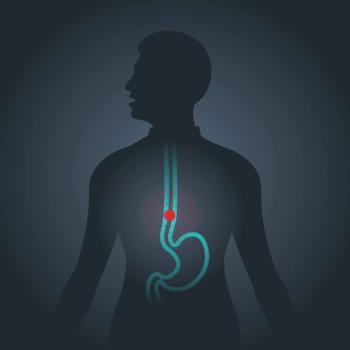
Oncology NEWS International
- Oncology NEWS International Vol 12 No 9
- Volume 12
- Issue 9
Photofrin for Barrett’s Esophagus
ROCKVILLE, Maryland-The Food and Drug Administration has approved Photofrin (porfimer sodium, Axcan Scandipharm) for the ablation of high-grade dysplasia in Barrett’s esophagus patients who do not undergo an esophagectomy. The agency acted less than 2 months after its Gastrointestinal and Coagulation Drugs Advisory Committee recommended that the FDA approve this new indication for the photodynamic therapy (PDT) agent.
ROCKVILLE, MarylandThe Food and Drug Administration has approved Photofrin (porfimer sodium, Axcan Scandipharm) for the ablation of high-grade dysplasia in Barrett’s esophagus patients who do not undergo an esophagectomy. The agency acted less than 2 months after its Gastrointestinal and Coagulation Drugs Advisory Committee recommended that the FDA approve this new indication for the photodynamic therapy (PDT) agent.
In Barrett’s esophagus, cells lining the lower portion of the esophagus are replaced by tissue normally found in the intestine. The ailment is associated with gastroesophageal reflux. An estimated 25,000 to 35,000 people in North America suffer from high-grade dysplasia associated with Barrett’s esophagus, and a small number of these patients go on to develop esophageal adenocarcinoma.
The FDA based its approval of Photo-frin for this condition on a multicenter clinical trial showing that patients treated with Photofrin-based PDT in combination with chemotherapy were more likely than patients who received only a cancer drug to have a complete reversal of their dysplasia. Moreover, the Photo-frin patients were more likely to be cancer-free 2 years after treatment than those not treated with PDT.
"The effectiveness of Photofrin PDT in reducing the long-term risk of esophageal cancer has not been demonstrated," the FDA said in announcing its marketing approval for the drug.
The FDA first approved Photofrin in 1998 for the partial reduction of obstruction and palliation in patients with endobronchial non-small-cell lung cancer (NSCLC). It subsequently approved Photofrin for the treatment of microin-vasive endobronchial NSCLC in patients for whom surgery and radiotherapy are not indicated, and for the palliation of patients with completely obstructing esophageal cancer or those with partial obstruction whose physicians believe they cannot be treated satisfactorily with an Nd:YAG laser.
The company’s pivotal study consisted of 208 Barrett’s esophagus patients treated in North American and Europe in a randomized, controlled, partially blinded study. In the study, 138 patients received Photofrin PDT plus omeprazole (Prilosec) and 70 received omeprazole only.
The two-stage treatment begins with an injection of the drug, an innocuous compound until it is exposed to light. The drug is cleared from most tissues in 40 to 72 hours, but it is selectively retained in tumors, skin, and organs of the reticuloendothelial system. Forty to 50 hours after injection, the dysplasia is exposed to a 680-nm wavelength laser light.
Researchers conducted endoscopic examinations of the patients every 3 months until they had four negatives tests in a row, and then semiannually until all patients completed at least 2 years of follow-up. The length of follow-up ranged from 2.0 to 3.6 years.
The study’s primary endpoint was the complete ablation of high-grade dysplasia at 24 months: 77% of the Photofrin-treated patients achieved complete ablation, compared with 39% of the omeprazole-only group (P < .0001).
An analysis of secondary endpoints showed the following:
- Mean ablation duration was 987 days in the Photofrin arm and 98 days in the omeprazole group.
- Twice the proportion of omepra-zole-only patients progressed to esophageal cancer, compared with those in the Photofrin arm (P = .006).
- Patients in both groups who failed to achieve a complete response had approximately a 10-fold higher risk of progressing to cancer than those with a compete response.
Because skin cells retain Photofrin for up to 90 days, people treated with the drug must protect their skin and eyes from exposure to direct sunlight and bright indoor lighting. Photofrin is currently in phase II studies for the treatment of cholangiocarcinoma.
Articles in this issue
over 22 years ago
Stroke a Late Effect of RT for Medulloblastomaover 22 years ago
Proteomic Patterns Find Ca in Men With High PSAover 22 years ago
VEGF Inhibitor Extends Survivalover 22 years ago
Gefitinib Fails to Stem Malignant Mesotheliomaover 22 years ago
Trastuzumab Shows Limited Promise in Non-Small-Cell Lung Cancerover 22 years ago
Gefitinib Shows Modest Activity Against Recurrent GlioblastomaNewsletter
Stay up to date on recent advances in the multidisciplinary approach to cancer.




